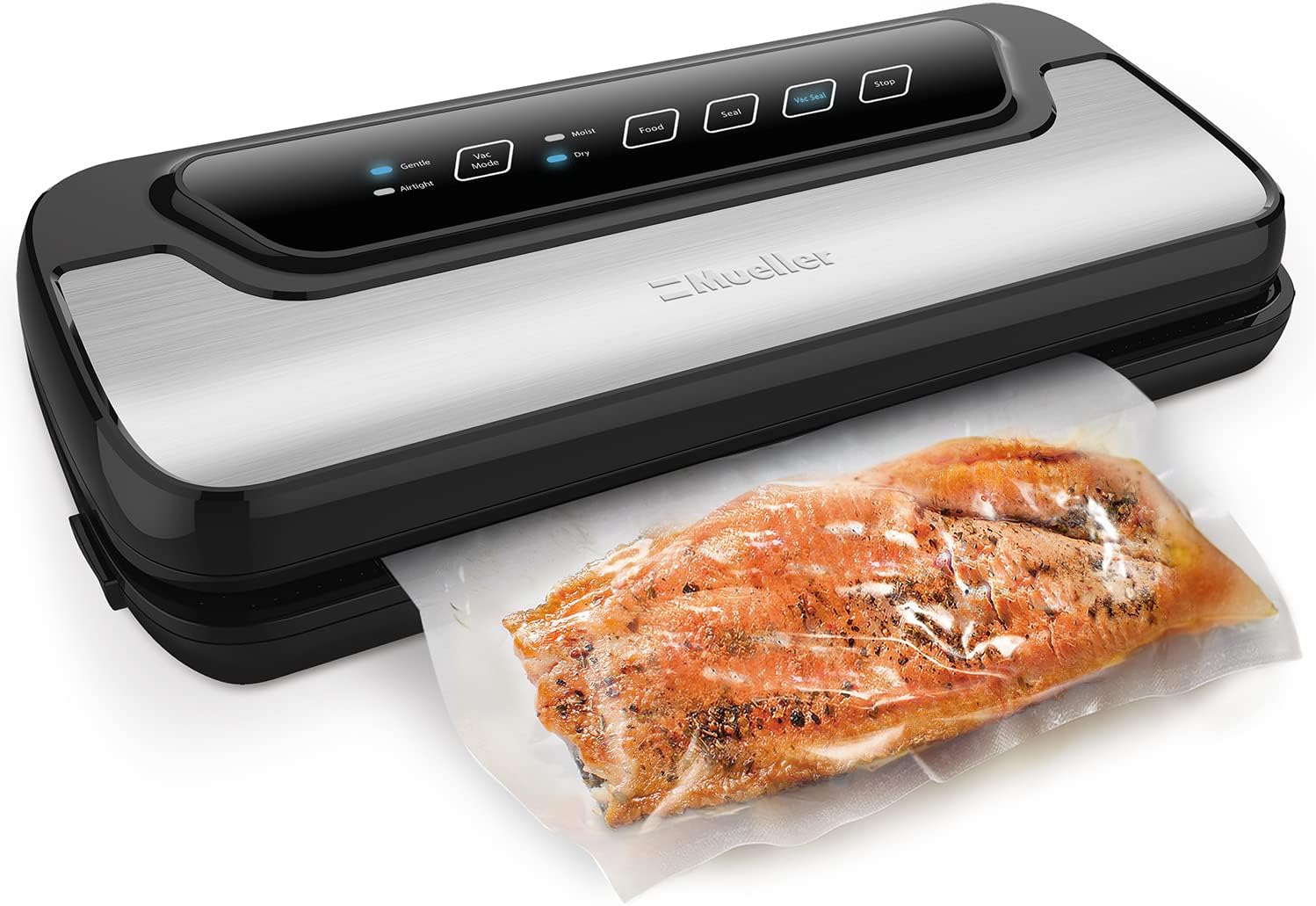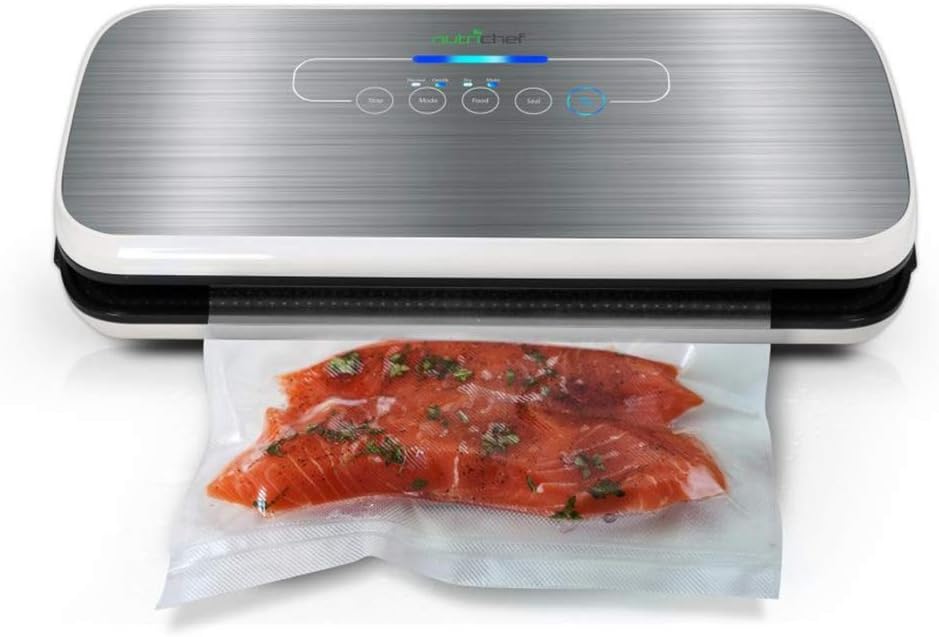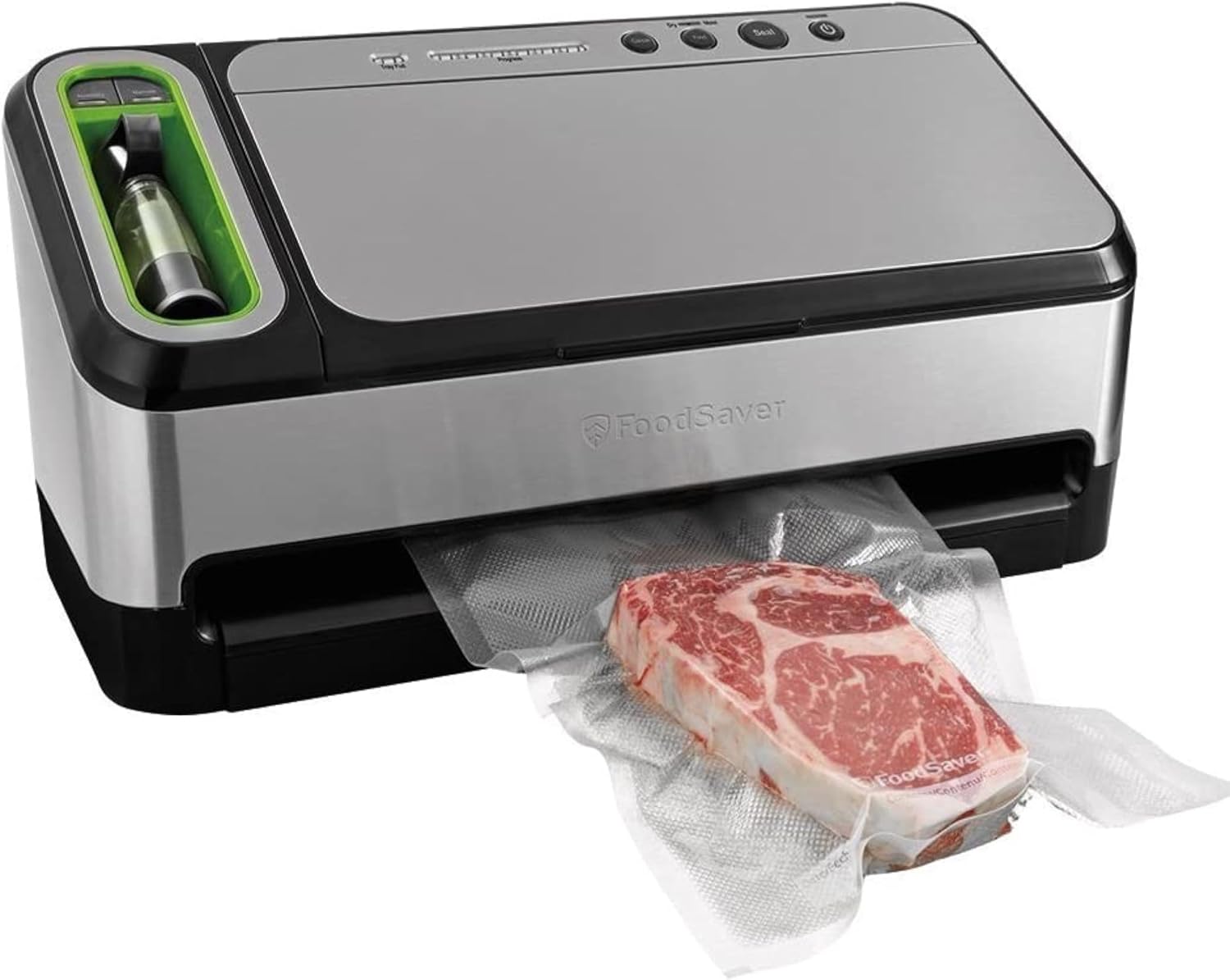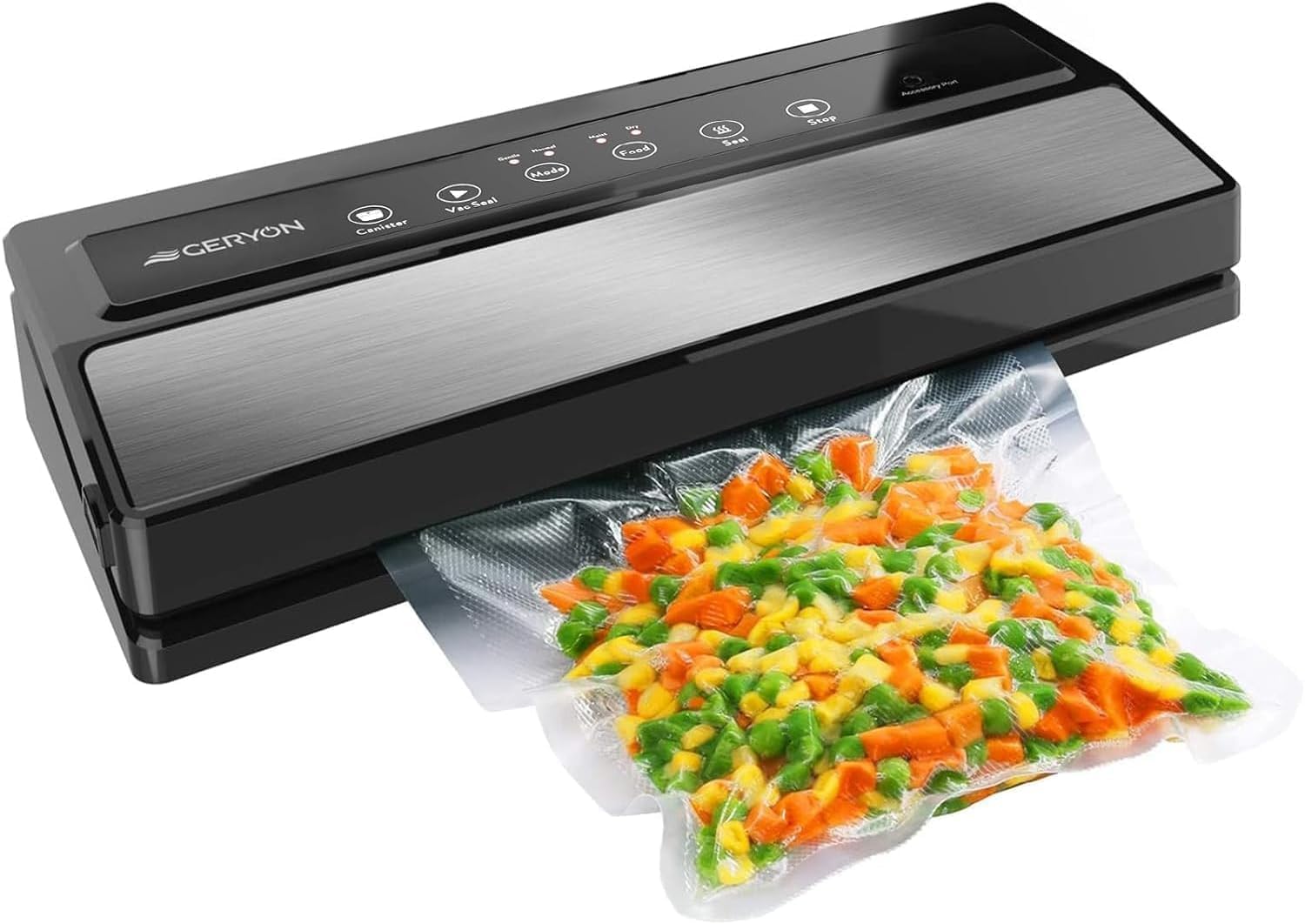In the quest for the ideal kitchen appliance, we recognize the essential role a vacuum sealer plays in a modern home. The Vacuum sealer has not only become an essential appliance in the regular kitchen, it is also of great benefit to those of us for who prepping is a lifestyle, and not just for foodstuffs either as will be highlighted later.
Navigating through the plethora of available options can be daunting, but the benefits make it a worthwhile endeavor. Vacuum sealers not only prolong the freshness of food, leading to less waste and more savings, but their daily use has become a practicality for many households looking to streamline their food preservation process.
That’s why we’ve carefully evaluated a wide range of vacuum sealers to help you find one that can seamlessly integrate into your daily routine. Understanding this tool’s fundamental purpose, the remarkable advantages it brings to every kitchen, and which features stand out the most, are all crucial aspects of our comprehensive guide. We’re here to ensure that the investment you make in a vacuum sealer translates into a long-term benefit for your home.
5 Leading Vacuum Sealers for Preserving Food and Saving Money
Selecting a top-tier vacuum sealer can significantly extend the freshness of your food, reduce waste, and save money. Our research and hands-on tests have determined several outstanding models that cater to diverse storage needs and budgets.
1. FoodSaver V4800 Vacuum Sealer with Automatic Bag Detection
Our prime choice for preserving food with convenience and efficiency. The automatic bag detection feature simplifies the process—insert the bag, and the sealer does the rest, guaranteeing a lasting seal. The model boasts a built-in roll storage and cutter for custom bag sizes, moisture detection, and an easily removable drip tray. Though slightly more expensive and larger, this sealer’s smart features justify the counter space.
2. Mueller Vacuum Sealer

3. NutriChef PKVS Vacuum Sealer

4. FoodSaver FM2000 Vacuum Sealer

5. GERYON Food Vacuum Sealer

The above selection offers strong contenders in the food vacuum sealer category. Each model comes with its unique set of features and considerations, ranging from high-end, feature-rich options to budget-conscious picks with essential functionalities. Weighing the benefits against any limitations will help in making an informed decision to fit your specific food preservation needs. Remember to also consider factors like ease of use, size, noise level, and additional functions when choosing a vacuum sealer that’s right for your home.
Understanding the Vacuum Sealer
A vacuum sealer simply removes air from a bag and seals it, compressing and protecting the bag’s contents.
The Merits of Vacuum Sealing
- Cost Effectiveness and Reducing Food Waste – Our homes can become centers for efficiency and savings, particularly in the kitchen. We’re all too familiar with the grim statistics of food waste, where families discard a considerable portion of their groceries, equating to a substantial sum of money annually. Investment in a vacuum sealing appliance not only lessens the waste of perishable items like fruits, vegetables, meats, and dairy, but also translates into significant financial savings. By sealing food before it spoils, we invest in both our wallets and a more sustainable world.
- Emergency Provisioning – Amidst our discussions on food preservation, vacuum sealing emerges as a remarkably economical strategy for amassing emergency food supplies. While freeze-drying may be unrivaled for extending shelf life, its high cost often places it beyond reach. In contrast, vacuum sealers, with a lower entry price, excel by eliminating air, thus impeding bacteria growth and spoilage. This process allows us to create a prolonged stockpile of nourishing food, ensuring readiness for unforeseen circumstances.
- Protective Waterproofing – Beyond food, vacuum sealers offer a protective advantage for essential non-food items. Waterproofing matches for outdoor expeditions or safeguarding ammunition and gear from moisture damage becomes simple with vacuum sealing. This versatility extends the functionality of sealers to safeguard valuables and essentials against the elements.
- Space Efficiency and Organization – Vacuum sealers are champions of space management. Whether it’s compressing bulky garments or organizing personal closets, these devices dramatically reduce item volume. This space-saving feature is particularly useful for those of us looking to maintain an orderly and accessible home environment.
- Enhancing Sous Vide Culinary Techniques – For enthusiasts of culinary precision, sous vide cooking presents an intriguing method where sealed food is immersed in a water bath at a controlled temperature. Key to this technique is the absence of direct contact with extreme heat sources, resulting in evenly cooked dishes that retain moisture and flavor. For sous vide, vacuum sealers paired with an immersion circulator become indispensable tools. Stand mixer attachments are additional accessories that further facilitate the preparation process for various recipes.
Key Features to Consider in Vacuum Sealers
Evaluating Vacuum Strength
When assessing vacuum sealers, the capability to effectively and efficiently extract air is paramount. A model with robust vacuum capabilities ensures a tight seal, preserving your food’s freshness for longer periods. Should you find yourself deciding between two models, opt for the one with superior suction.
- Ease of Use with Integrated Bag Detection – Vacuum sealers equipped with an automatic bag recognition system streamline the sealing process. Simply place the bag’s end into the sealer, and the device will initiate the vacuum cycle without additional user input, bypassing the need for manual controls or buttons. This feature is a boon for efficiency and ease of operation.
- Versatility via Accessory Port – The inclusion of an accessory hose significantly expands the functionality of a vacuum sealer, granting the versatility to evacuate air from containers beyond bags, such as mason jars. An accessory port is an attribute that enhances the overall utility of the device.
- Convenience of Internal Bag Storage – Models that incorporate internal storage for bag rolls paired with an onboard cutter enhance convenience and reduce waste. The ability to tailor bag sizes to your specific needs means that you only use the precise amount of material required, making for a more efficient and economical sealing process.
- Maintenance with Detachable Drip Tray – For those who frequently seal moist foods, a removable drip tray is a must. This feature collects any excess liquid, preventing spillage and facilitating straightforward cleaning, ensuring hygiene without the hassle of washing the entire unit.
- Single Seal Functionality – A ‘Seal Only’ option offers additional flexibility. This feature is particularly useful when you are preparing custom-sized bags from rolls. It allows you to forge an initial seal on one end of the bag, preparing it for the vacuum cycle without prematurely removing air, thereby enabling a two-stage preparation process conducive to practical and bespoke packaging solutions.
Vacuum Sealed Food Lifespan
When vacuum sealing food, its longevity is influenced by the food’s category, preparation method, and the type of storage bag. For instance, dry goods can maintain their quality for an extended period when stored in Mylar bags with oxygen absorbers, potentially for decades.
In terms of perishables, the key to enhancing shelf life lies in effectively removing moisture. Foods with lower water content are less prone to mold, bacterial growth, and oxidation. This means dehydrated fruits and vegetables can remain edible for a significant amount of time if air and humidity are adequately controlled.
- Dry Goods: Up to decades in Mylar bags with oxygen absorbers
- Dehydrated Produce: Extended shelf life with proper moisture removal
Optimal Selection of Bags (Balancing Ease-of-Use and Cost)
- Sealing Pouches – Sealing pouches are tailor-made for vacuum sealers, featuring tiny protrusions along their surfaces. These minute elevations are not merely decorative; they form critical air pathways which enable the machine to evacuate air from the sealed environment. Without these protrusions, the two smooth plastic surfaces would stick together, impeding air suction. Although they represent a perfect match for daily vacuum sealing needs, they might not be the top choice for exceptionally long-term food preservation, for which we’ll look to another option.
- Reinforced Foil Pouches – Reinforced foil pouches—or Mylar bags—are the heavyweights of food preservation, capable of maintaining a seal that lasts years or potentially even decades. Due to their virtually non-porous nature, extracting air from Mylar bags can be challenging. However, by integrating a strip of the textured material from the sealing pouches, we can fashion an impromptu channel to allow for the air evacuation process. This cost-effective hack enables these barriers to gulp air efficiently, enabling them to work with vacuum sealers.
- Reusable Closure Bags – Reusable closure bags, such as those akin to the ubiquitous Ziploc, are prized for their simplicity and convenience. The household staple versions aren’t designed with vacuum sealing in mind. Moreover, while there are vacuum sealable varieties available, they can be rather costly. Through a series of added procedures, standard closure bags can still be used effectively with a vacuum sealer and be a more pocket-friendly option, even if it requires a bit more effort. This approach helps us save money without compromising on our vacuum sealing tasks.
Sealing Techniques for a Variety of Foods
- Securing Meats for the Freezer – When buying meats in large quantities, proper storage is key to maintain freshness and prevent freezer burn. The process is straightforward: we ensure all the air is removed, which aids in preserving the meat’s quality until we’re ready to enjoy it.
- Keeping Avocados Fresh – Ever faced the disappointment of avocados going bad quickly? Well, with the right sealing technique, we can bulk purchase avocados without the typical risk. We ensure avocados are sealed in a way that extends their freshness significantly.
- Preservation of Fish and Game – For those of us who appreciate the delicacy of fish and the robust flavors of wild game, we’ve discovered methods to season and prepare these proteins to be vacuum sealed, which retains their flavor and texture magnificently.
- Vacuum Sealing Soups Successfully – Despite popular belief, it is indeed feasible to vacuum seal soups without mess. We utilize certain techniques that prevent the liquid from interfering with the sealing process, allowing us to store soups long-term without issue.
- Storing Bread and Buns Without Squishing – To avoid the common issue of flattened bread or hamburger buns post-sealing, we’ve mastered a method that allows us to seal these soft items while maintaining their shape and texture, ensuring they come out just as fresh as when they went in. See number 8!
- Effectively Sealing Moist Foods – We’ve found that sealing moist foods doesn’t have to be a sloppy affair. With the right bags and a bit of know-how regarding the sealer’s features, such as drip trays, it becomes a clean and easy task.
- Ensuring Flour’s Freshness for Extended Periods – When it comes to flour, we make sure to store it in a way that not only prolongs its shelf-life but also maintains its quality for our future baking endeavors, all by leveraging the sealing techniques we’ve refined.
- Safeguarding Soft Foods from Squishing – We’ve learned a valuable trick for vacuum sealing soft foods like berries and soft cheeses without turning them into a squished mess. The key is to freeze these items first, granting them the firmness needed to withstand the air extraction process.
- For Dry Foods: We use a ‘dry’ setting on our vacuum sealer to ensure a strong and secure seal.
- For Moist Foods: We opt for the ‘moist’ setting to accommodate any extra liquid, such as marinated meats.
By applying specific settings and procedures, we’re able to vacuum seal everything from delicate cereals to a bone-in pork chop without compromising the integrity of the food. Whether we’re planning a meal prep or storing our catch from a fishing trip, these techniques allow us to keep our food fresh and tasty.
Preppers Take Note: Vacuum Sealing isn’t ONLY for Food!
- Food Preservation – The primary use, but not the only one! We often need to preserve various foods, ranging from meats to fruits and snacks. Vacuum sealing can extend their shelf life by removing air and sealing freshness in.
- Power Sources – To maintain the longevity of batteries and ensure they remain dry, vacuum sealing is a reliable method, especially for batteries stored in emergency kits.
- Combustion Tools – We understand the importance of starting a fire for warmth and cooking. Keeping matches and lighters dry by vacuum sealing them prevents a no-spark situation in damp environments.
- Ammunition Storage – For those who prioritize preparedness, protecting ammunition against rust and moisture is crucial. Vacuum sealing is an ideal solution, particularly for buried caches.
- Medication Longevity – We advocate moving medications from their original containers to Mylar bags and sealing them for extended storage, safeguarding their efficacy.
- Protective First Aid Measures – Since most small first aid kits are not inherently waterproof, vacuum sealing them ensures they remain dry and sterile.
- Writing Implements – To prevent ink from drying out, we suggest vacuum sealing sharpie markers and pens, preserving their utility for when you need them.
- Culinary Enhancers – To retain the potency and taste of spices over time, we use chamber vacuum sealers, which helps preserve their quality.
- Communication Equipment – Storing a hand-crank radio in a Mylar bag can act as a Faraday cage, protecting it from electromagnetic pulses, thus ensuring emergency communication readiness.
- Firearms Maintenance – In damp conditions, such as within survival caches, our practice includes vacuum sealing firearms to prevent moisture damage.
- Seed Preservation – In preparation for a self-sustainable future, we seal seeds to protect their germination potential and their value in a trade economy.
- Document and Photo Protection – We employ vacuum sealing for important documents and photographs as a safeguard against water damage, ensuring their preservation.
- Personal Garments – For emergency clothing such as socks, underwear, and shirts, we vacuum seal them to compress their size and secure them from water exposure.
Final Thoughts
Securing a vacuum sealer elevates our food preservation game, ensuring longevity with each seal. By removing air and moisture, we reduce spoilage, reinforcing our pantry with lasting supplies. It’s a smart, cost-effective strategy for enhancing our self-sufficiency.


